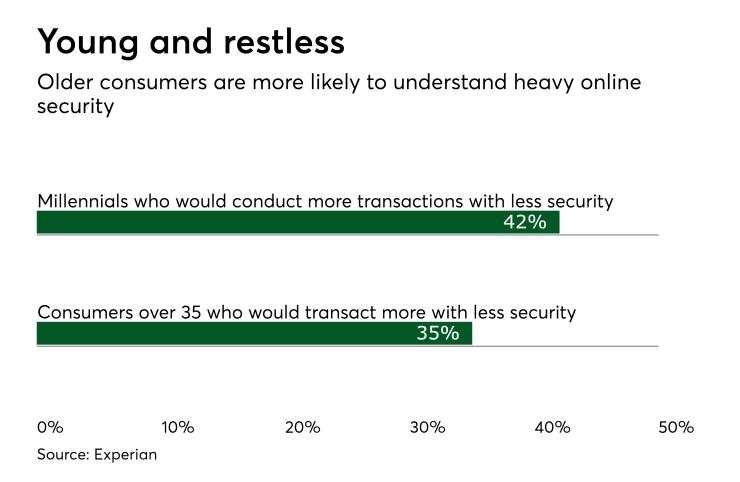As businesses, we’re often looking for ways to further enhance customer experience. Whether a brick-and-mortar, online retailer, or combination of both, we need to be thinking about how to protect consumers from fraud while also providing a convenient and positive experience.
While there might not be a one-size-fits-all solution, recent studies show that we should at least keep in mind that while consumers hold businesses responsible for protecting their data, not all consumers have the same mindset when it comes to best practices in doing so.
We recently surveyed more than 5,500 consumers and 500 businesses worldwide to gain a better understanding of the investments companies are making in customer recognition and fraud risk mitigation, as well as consumers’ thoughts about online security procedures. In our 2018 Global Fraud and Identity report, we shared our findings about consumer tolerance toward these protocols, which varied by age.

Out of all consumers surveyed, 42 percent of millennials said they would conduct more online transactions if there weren’t so many security hurdles to overcome, versus 30 percent of those who are 35 and older. Based on this research, we concluded that younger consumers are generally less tolerant of security hurdles and are more inclined to engage online if there was less friction.
The challenge here for businesses is to create a good balance between providing a positive experience for consumers while having efficient security measures that protect them from potential data breaches. However, it’s hard to find just one solution that is well suited for all consumers due to the varying degree of tolerance toward security. Millennials are part of a generation that grew up with mobile phones, computers, and the Internet, and are accustomed to convenience and speed.
Older generations have lived through different time periods when people didn’t have access to answers in seconds, whether by asking Siri a question or pulling up Google on a smartphone. Therefore, it’s understandable to have one age group appear a bit more patient than the other when it comes to identity verification and overall security online.
Our latest research also shows that when it comes to protecting consumers from fraud, most businesses prioritize convenience over security, and most have come to terms with acceptable levels of losses. Approximately 52 percent of businesses still use passwords as their top form of authentication because it’s a well-understood security precaution, and customers have grown accustomed to them.
Although most leaders don’t believe passwords to be the safest method of fraud prevention, it seems to be the most basic level of visible security that is the most time-tested. Ironically, though, passwords still aren’t a perfect solution for millennials and other generations, because one-quarter of consumers have forgotten a username or password within the past six months. In fact, the top three barriers encountered when banking online are: forgotten username or password; locked out for mistyping a password too many times; and secret or personal questions prior to access being granted.
For businesses that serve a predominantly millennial audience, knowing the age group’s tolerance toward online security measures is an important lesson that coincides with customer retention. Ultimately, you want to provide an acceptable level of security to protect your customers, but at the same time want to be able to make it easy for consumers to interact with your brand. Once you find the secret sauce that fits your business, that’s when you know you’re building valuable brand loyalty one step at a time.





